Blog & Latest Updates
Fly Fishing Articles
Insects by Common Name


Updates from February 5, 2004
Photos by Troutnut from the East Fork of the Iron River, Schacte Creek, and the Bois Brule River in Wisconsin
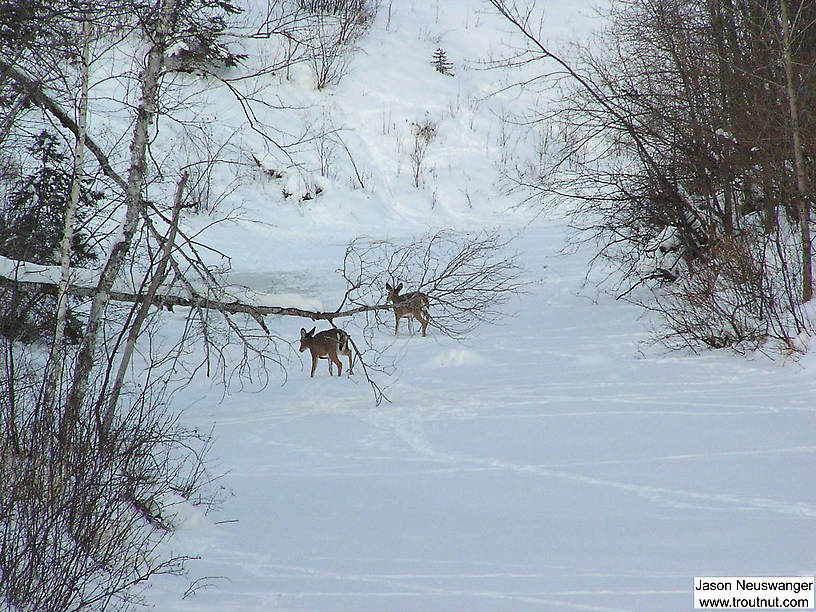
Two dear make tracks across a frozen trout stream in the deep snows of early February not far from Lake Superior. I had hoped to sample nymphs in the stream (which later turned out to be quite fertile) but it wasn't open.
StateWisconsin
LocationEast Fork of the Iron River
Date TakenFeb 5, 2004
Date AddedJan 25, 2006
AuthorTroutnut
CameraOlympus C740UZ
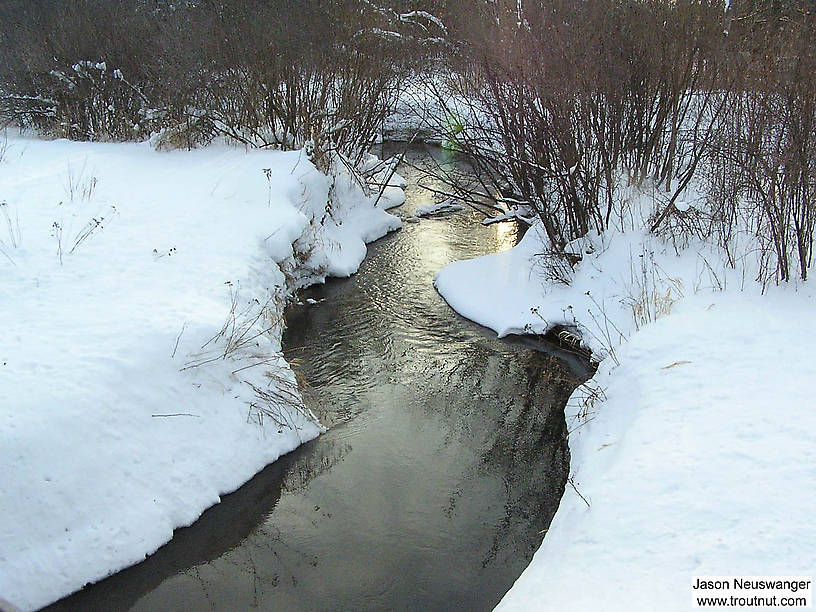
This tiny spring creek is extremely fertile, and I sampled many interesting insects I didn't find anywhere else. The water was completely open even though other nearby spring creeks were frozen over and the snow was three feet deep.
StateWisconsin
LocationSchacte Creek
Date TakenFeb 5, 2004
Date AddedJan 25, 2006
AuthorTroutnut
CameraOlympus C740UZ
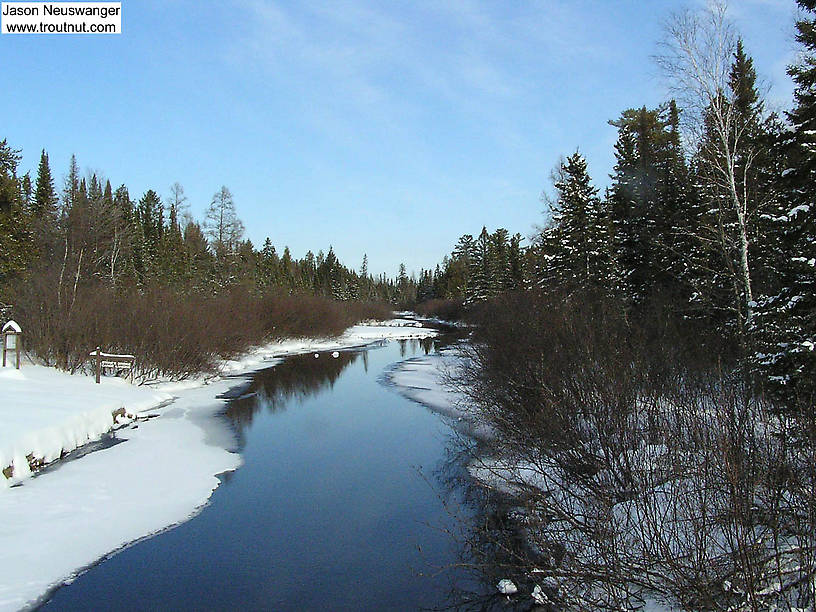
Here's another of my very frigid early nymph sampling sites.
StateWisconsin
LocationBois Brule River
Date TakenFeb 5, 2004
Date AddedJan 25, 2006
AuthorTroutnut
CameraOlympus C740UZ
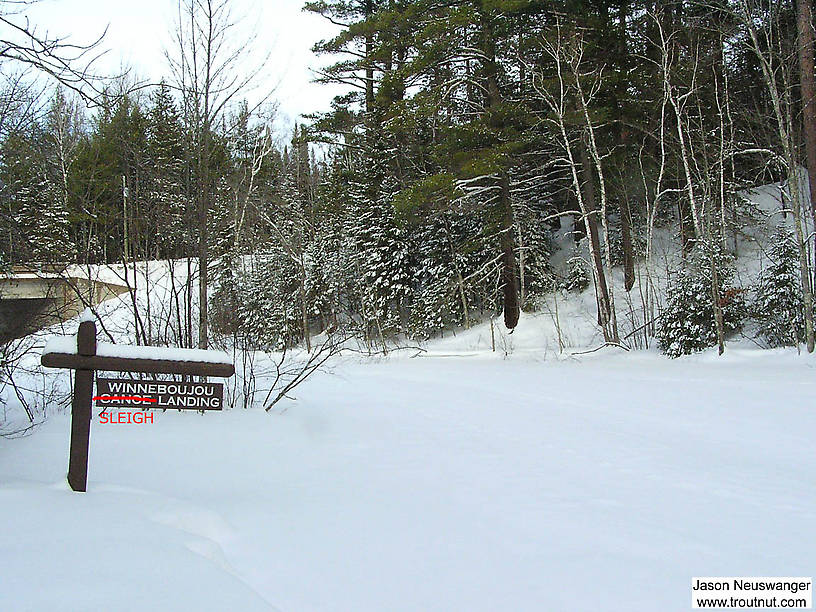
I had hoped to sample some nymphs here, but I didn't bring an ice auger.
StateWisconsin
LocationBois Brule River
Date TakenFeb 5, 2004
Date AddedJan 25, 2006
AuthorTroutnut
CameraOlympus C740UZ
Closeup insects by Troutnut from Miscellaneous Wisconsin, the Bois Brule River, Schacte Creek, the Namekagon River, and Schacte Creek in Wisconsin
Ephemerella aurivillii Mayfly Nymph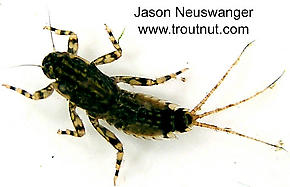 View 5 PicturesClose examination under a microscope showed definite small tubercles (
View 5 PicturesClose examination under a microscope showed definite small tubercles (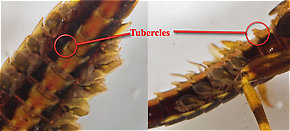 Tubercle: Various peculiar little bumps or projections on an insect. Their character is important for the identification of many kinds of insects, such as the nymphs of Ephemerellidae mayflies.) on the back of this nymph.
Tubercle: Various peculiar little bumps or projections on an insect. Their character is important for the identification of many kinds of insects, such as the nymphs of Ephemerellidae mayflies.) on the back of this nymph.
 View 5 PicturesClose examination under a microscope showed definite small tubercles (
View 5 PicturesClose examination under a microscope showed definite small tubercles (
A few (not all) of the abdominal tubercles on this Ephemerella needhami nymph are circled. They are especially large in this species.
Collected February 5, 2004 from unknown in Wisconsin
Added to Troutnut.com by Troutnut on January 25, 2006
Added to Troutnut.com by Troutnut on January 25, 2006
Ephemera simulans (Brown Drake) Mayfly Nymph View 5 Pictures
View 5 Pictures
 View 5 Pictures
View 5 PicturesCollected February 5, 2004 from unknown in Wisconsin
Added to Troutnut.com by Troutnut on January 25, 2006
Added to Troutnut.com by Troutnut on January 25, 2006
Leptophlebia (Black Quills and Blue Quills) Mayfly Nymph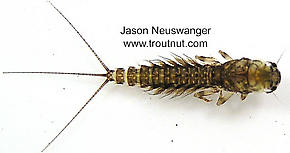 View 5 PicturesI think this one might be Leptophlebia intermedia.
View 5 PicturesI think this one might be Leptophlebia intermedia.
 View 5 PicturesI think this one might be Leptophlebia intermedia.
View 5 PicturesI think this one might be Leptophlebia intermedia.Collected February 5, 2004 from the Bois Brule River in Wisconsin
Added to Troutnut.com by Troutnut on January 25, 2006
Added to Troutnut.com by Troutnut on January 25, 2006
Sialis Alderfly Larva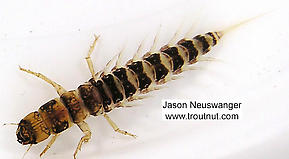 View 4 Pictures
View 4 Pictures
 View 4 Pictures
View 4 PicturesCollected February 5, 2004 from unknown in Wisconsin
Added to Troutnut.com by Troutnut on January 25, 2006
Added to Troutnut.com by Troutnut on January 25, 2006
Sialis Alderfly Larva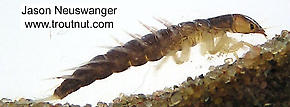 View 4 Pictures
View 4 Pictures
 View 4 Pictures
View 4 PicturesCollected February 5, 2004 from unknown in Wisconsin
Added to Troutnut.com by Troutnut on January 25, 2006
Added to Troutnut.com by Troutnut on January 25, 2006
Isoperla (Stripetails and Yellow Stones) Stonefly Nymph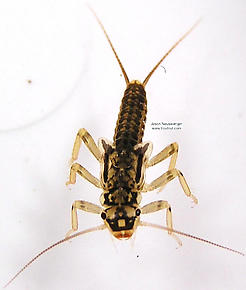 View 4 Pictures
View 4 Pictures
 View 4 Pictures
View 4 PicturesCollected February 5, 2004 from unknown in Wisconsin
Added to Troutnut.com by Troutnut on January 25, 2006
Added to Troutnut.com by Troutnut on January 25, 2006
Limnephilidae (Northern Caddisflies) Caddisfly Larva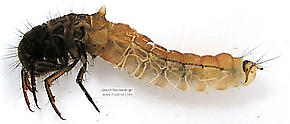 View 3 Pictures
View 3 Pictures
 View 3 Pictures
View 3 PicturesCollected February 5, 2004 from unknown in Wisconsin
Added to Troutnut.com by Troutnut on January 25, 2006
Added to Troutnut.com by Troutnut on January 25, 2006
Ephemera simulans (Brown Drake) Mayfly Nymph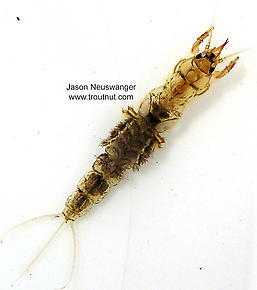 View 5 Pictures
View 5 Pictures
 View 5 Pictures
View 5 PicturesCollected February 5, 2004 from the Bois Brule River in Wisconsin
Added to Troutnut.com by Troutnut on January 25, 2006
Added to Troutnut.com by Troutnut on January 25, 2006
Trichoptera (Caddisflies) Caddisfly Larva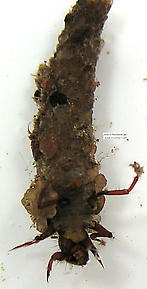 View 4 Pictures
View 4 Pictures
 View 4 Pictures
View 4 PicturesCollected February 5, 2004 from unknown in Wisconsin
Added to Troutnut.com by Troutnut on January 25, 2006
Added to Troutnut.com by Troutnut on January 25, 2006
Ephemerella aurivillii Mayfly Nymph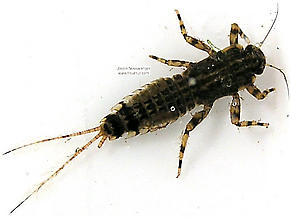 View 4 Pictures
View 4 Pictures
 View 4 Pictures
View 4 PicturesCollected February 5, 2004 from unknown in Wisconsin
Added to Troutnut.com by Troutnut on January 25, 2006
Added to Troutnut.com by Troutnut on January 25, 2006
Baetidae (Blue-Winged Olives) Mayfly Nymph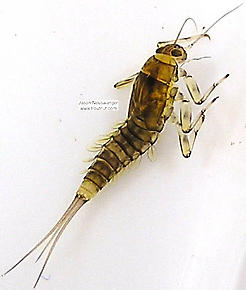 View 4 PicturesThis Baetis nymph is quite a bit larger than any of the others I found in winter 2004. Abdomen segment 5 is only slightly pale while 9 and 10 are quite pale. The tail is banded at the tip. Its body measures about 9mm long. It's much larger than the other Baetis specimens I collected, and it has quite well-developed wingpads.
View 4 PicturesThis Baetis nymph is quite a bit larger than any of the others I found in winter 2004. Abdomen segment 5 is only slightly pale while 9 and 10 are quite pale. The tail is banded at the tip. Its body measures about 9mm long. It's much larger than the other Baetis specimens I collected, and it has quite well-developed wingpads.
It's most likely a mature nymph from a very early-hatching brood. It comes from the headwaters of a very small, very spring-fed Lake Superior tributary, which wasn't at all frozen despite very frigid temperatures and 3 feet of snow on the ground.
 View 4 PicturesThis Baetis nymph is quite a bit larger than any of the others I found in winter 2004. Abdomen segment 5 is only slightly pale while 9 and 10 are quite pale. The tail is banded at the tip. Its body measures about 9mm long. It's much larger than the other Baetis specimens I collected, and it has quite well-developed wingpads.
View 4 PicturesThis Baetis nymph is quite a bit larger than any of the others I found in winter 2004. Abdomen segment 5 is only slightly pale while 9 and 10 are quite pale. The tail is banded at the tip. Its body measures about 9mm long. It's much larger than the other Baetis specimens I collected, and it has quite well-developed wingpads. It's most likely a mature nymph from a very early-hatching brood. It comes from the headwaters of a very small, very spring-fed Lake Superior tributary, which wasn't at all frozen despite very frigid temperatures and 3 feet of snow on the ground.
Collected February 5, 2004 from Schacte Creek, Bayfield County in Wisconsin
Added to Troutnut.com by Troutnut on January 25, 2006
Added to Troutnut.com by Troutnut on January 25, 2006
Paraleptophlebia (Blue Quills and Mahogany Duns) Mayfly Nymph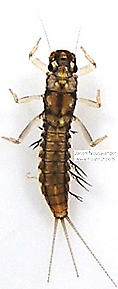 View 4 PicturesThis one is missing several gills due to capture damage.
View 4 PicturesThis one is missing several gills due to capture damage.
 View 4 PicturesThis one is missing several gills due to capture damage.
View 4 PicturesThis one is missing several gills due to capture damage.Collected February 5, 2004 from unknown in Wisconsin
Added to Troutnut.com by Troutnut on January 25, 2006
Added to Troutnut.com by Troutnut on January 25, 2006
Limnephilidae (Northern Caddisflies) Caddisfly Larva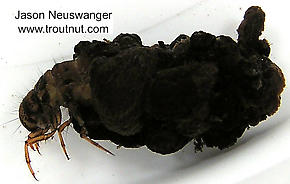 View 3 Pictures
View 3 Pictures
 View 3 Pictures
View 3 PicturesCollected February 5, 2004 from unknown in Wisconsin
Added to Troutnut.com by Troutnut on January 25, 2006
Added to Troutnut.com by Troutnut on January 25, 2006
Chironomidae (Midges) Midge Larva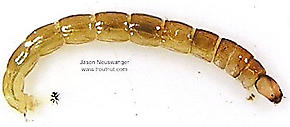 View 3 PicturesThis large midge larva is about 3/4" long.
View 3 PicturesThis large midge larva is about 3/4" long.
 View 3 PicturesThis large midge larva is about 3/4" long.
View 3 PicturesThis large midge larva is about 3/4" long.Collected February 5, 2004 from unknown in Wisconsin
Added to Troutnut.com by Troutnut on January 25, 2006
Added to Troutnut.com by Troutnut on January 25, 2006
Ephemerella aurivillii Mayfly Nymph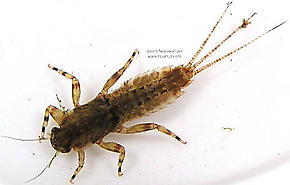 View 3 PicturesThis specimen seems to be morphologically identical to the darker specimens of its species, but it's a very distinctly different color. I'm guessing this is a gender difference, just as I've guessed for the similar E. subvaria nymphs.
View 3 PicturesThis specimen seems to be morphologically identical to the darker specimens of its species, but it's a very distinctly different color. I'm guessing this is a gender difference, just as I've guessed for the similar E. subvaria nymphs.
 View 3 PicturesThis specimen seems to be morphologically identical to the darker specimens of its species, but it's a very distinctly different color. I'm guessing this is a gender difference, just as I've guessed for the similar E. subvaria nymphs.
View 3 PicturesThis specimen seems to be morphologically identical to the darker specimens of its species, but it's a very distinctly different color. I'm guessing this is a gender difference, just as I've guessed for the similar E. subvaria nymphs.Collected February 5, 2004 from unknown in Wisconsin
Added to Troutnut.com by Troutnut on January 25, 2006
Added to Troutnut.com by Troutnut on January 25, 2006
Leptophlebia cupida (Borcher Drake) Mayfly Nymph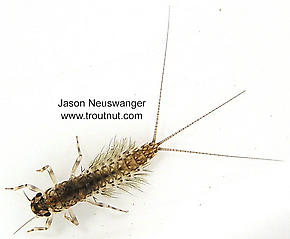 View 5 Pictures
View 5 Pictures
 View 5 Pictures
View 5 PicturesCollected February 5, 2004 from the Namekagon River in Wisconsin
Added to Troutnut.com by Troutnut on January 25, 2006
Added to Troutnut.com by Troutnut on January 25, 2006
Taeniopteryx (Early Black Stoneflies) Stonefly Nymph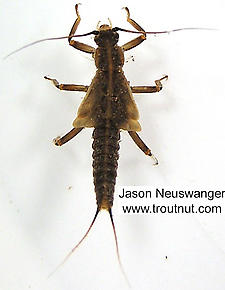 View 3 Pictures
View 3 Pictures
 View 3 Pictures
View 3 PicturesCollected February 5, 2004 from unknown in Wisconsin
Added to Troutnut.com by Troutnut on January 25, 2006
Added to Troutnut.com by Troutnut on January 25, 2006
Leptophlebia cupida (Borcher Drake) Mayfly Nymph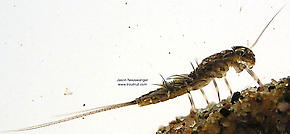 View 3 Pictures
View 3 Pictures
 View 3 Pictures
View 3 PicturesCollected February 5, 2004 from the Bois Brule River in Wisconsin
Added to Troutnut.com by Troutnut on January 25, 2006
Added to Troutnut.com by Troutnut on January 25, 2006
Eurylophella (Chocolate Duns) Mayfly Nymph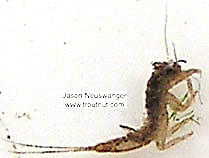 View 3 Pictures
View 3 Pictures
 View 3 Pictures
View 3 PicturesCollected February 5, 2004 from unknown in Wisconsin
Added to Troutnut.com by Troutnut on January 25, 2006
Added to Troutnut.com by Troutnut on January 25, 2006
Ephemerella aurivillii Mayfly Nymph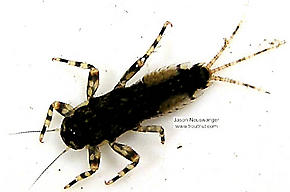 View 3 Pictures
View 3 Pictures
 View 3 Pictures
View 3 PicturesCollected February 5, 2004 from unknown in Wisconsin
Added to Troutnut.com by Troutnut on January 25, 2006
Added to Troutnut.com by Troutnut on January 25, 2006
Ephemerella aurivillii Mayfly Nymph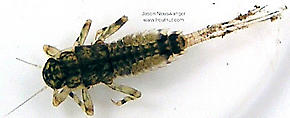 View 3 PicturesExamination of this specimen under a microscope revealed that it does have small abdominal tubercles (
View 3 PicturesExamination of this specimen under a microscope revealed that it does have small abdominal tubercles ( Tubercle: Various peculiar little bumps or projections on an insect. Their character is important for the identification of many kinds of insects, such as the nymphs of Ephemerellidae mayflies.), 2-banded femora (
Tubercle: Various peculiar little bumps or projections on an insect. Their character is important for the identification of many kinds of insects, such as the nymphs of Ephemerellidae mayflies.), 2-banded femora (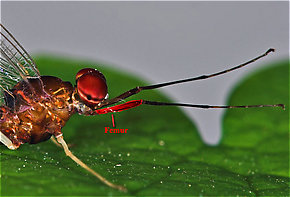 Femur: The main segment of an insect's leg close to the body, in between the tibia and the trochanter.), and banded tails.
Femur: The main segment of an insect's leg close to the body, in between the tibia and the trochanter.), and banded tails.
 View 3 PicturesExamination of this specimen under a microscope revealed that it does have small abdominal tubercles (
View 3 PicturesExamination of this specimen under a microscope revealed that it does have small abdominal tubercles (
A few (not all) of the abdominal tubercles on this Ephemerella needhami nymph are circled. They are especially large in this species.

The femur of this Isonychia bicolor mayfly spinner is highlighted in red.
Collected February 5, 2004 from unknown in Wisconsin
Added to Troutnut.com by Troutnut on January 25, 2006
Added to Troutnut.com by Troutnut on January 25, 2006
Dicranota True Fly Larva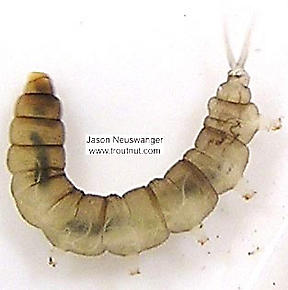 View 3 Pictures
View 3 Pictures
 View 3 Pictures
View 3 PicturesCollected February 5, 2004 from unknown in Wisconsin
Added to Troutnut.com by Troutnut on January 25, 2006
Added to Troutnut.com by Troutnut on January 25, 2006
Baetidae (Blue-Winged Olives) Mayfly Nymph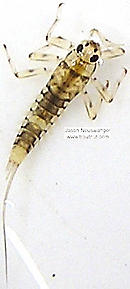 View 3 PicturesThis Baetid nymph has no tracheation on its gills, no distinct bands on its tails, and a rounded, oval 7th gill. Abdominal segments 5, 9, and 10 are pale.
View 3 PicturesThis Baetid nymph has no tracheation on its gills, no distinct bands on its tails, and a rounded, oval 7th gill. Abdominal segments 5, 9, and 10 are pale.
 View 3 PicturesThis Baetid nymph has no tracheation on its gills, no distinct bands on its tails, and a rounded, oval 7th gill. Abdominal segments 5, 9, and 10 are pale.
View 3 PicturesThis Baetid nymph has no tracheation on its gills, no distinct bands on its tails, and a rounded, oval 7th gill. Abdominal segments 5, 9, and 10 are pale.Collected February 5, 2004 from unknown in Wisconsin
Added to Troutnut.com by Troutnut on January 25, 2006
Added to Troutnut.com by Troutnut on January 25, 2006
Simuliidae (Black Flies) Black Fly Larva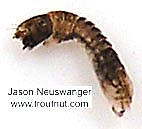 View 3 Pictures
View 3 Pictures
 View 3 Pictures
View 3 PicturesCollected February 5, 2004 from Schacte Creek in Wisconsin
Added to Troutnut.com by Troutnut on January 25, 2006
Added to Troutnut.com by Troutnut on January 25, 2006
Chironomidae (Midges) Midge Larva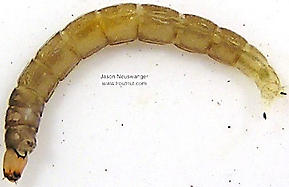 View 2 Pictures
View 2 Pictures
 View 2 Pictures
View 2 PicturesCollected February 5, 2004 from unknown in Wisconsin
Added to Troutnut.com by Troutnut on January 25, 2006
Added to Troutnut.com by Troutnut on January 25, 2006
Ephemerella aurivillii Mayfly Nymph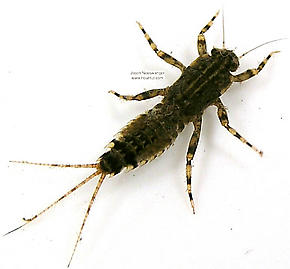 View 3 Pictures
View 3 Pictures
 View 3 Pictures
View 3 PicturesCollected February 5, 2004 from unknown in Wisconsin
Added to Troutnut.com by Troutnut on January 25, 2006
Added to Troutnut.com by Troutnut on January 25, 2006
Baetidae (Blue-Winged Olives) Mayfly Nymph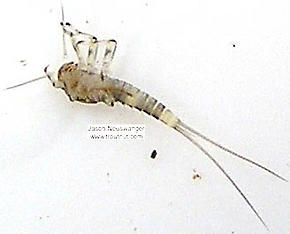 View 3 Pictures
View 3 Pictures
 View 3 Pictures
View 3 PicturesCollected February 5, 2004 from unknown in Wisconsin
Added to Troutnut.com by Troutnut on January 25, 2006
Added to Troutnut.com by Troutnut on January 25, 2006
Baetidae (Blue-Winged Olives) Mayfly Nymph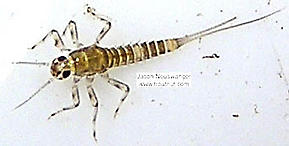 View 3 PicturesThis little Baetid looks a little stiff because it died shortly before being photographed.
View 3 PicturesThis little Baetid looks a little stiff because it died shortly before being photographed.
 View 3 PicturesThis little Baetid looks a little stiff because it died shortly before being photographed.
View 3 PicturesThis little Baetid looks a little stiff because it died shortly before being photographed.Collected February 5, 2004 from the Bois Brule River in Wisconsin
Added to Troutnut.com by Troutnut on January 25, 2006
Added to Troutnut.com by Troutnut on January 25, 2006
Hydropsychidae Caddisfly Larva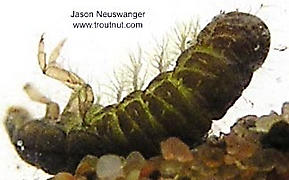 View 2 Pictures
View 2 Pictures
 View 2 Pictures
View 2 PicturesCollected February 5, 2004 from unknown in Wisconsin
Added to Troutnut.com by Troutnut on January 25, 2006
Added to Troutnut.com by Troutnut on January 25, 2006
Most recent comments on this post (latest on top)
Comment on this post
Top 10 Fly Hatches
Top Gift Shop Designs
Eat mayflies.
Top Insect Specimens
Miscellaneous Sites
Troutnut.com is copyright © 2004-2024 Jason
Neuswanger (email Jason). See my FAQ for information about use of my images.
 privacy policy
privacy policy
